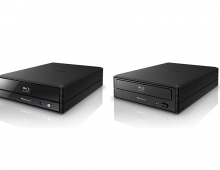
TDK Starts Mass Production of Blu-Ray Media
Japanese TDK said that it has started mass producrtion of non-cartridged recordable and rewritable Blu-Ray media, unveiling plans for commercialization as soon as the licensing procedure is completed.
The company has already showcased prototypes of single and dual layer versions of its BD-R (recordable) and BD-RE (rewritable) discs at CEATEC last October. Currently, TDK has started to mass produce samples of 25-50GB BD-R and BD-RE and plans to achieve a monthly production of 100,000 discs by the spring of 2006. The media will support recording at 2x (72Mbps).
Both BD-R and BD-RE media feature TDK's DURABIS 2 hard coating technology, developed exclusively for the Blu-Ray media. DURABIS coating technology is claimed to protect the sensitive Blu-Ray media from scratches, fingerprints and other factors that could make a disc unusable. This protection technology allowed TDK to deliver bare Blu-Ray media without a protective cartridge.

TDK said that it used a new recording layer of an inorganic material which is unaffected by exposure to lightfrom, a factor that could accelerate the ageing of the Blu-Ray discs. In addition, the BD-RE media are claimed to offer a 10,000 rewrite cycle.
TDK also said that its dual layer media, due to a high-precision spin coating that creates a flat cover layer, feature the optimal optical characterisitcs in terms of sensitivity, transparency and reflectivity of the two layers, that will result in consistent playback and recording compatibility. TDK also applied a high-precision stacking technology which precisely overlays disc layers.
In the case of BD-R, instead of a phase change or a dye layer, TDK applied a Cu/Si bilayer as the recording medium. The write process basically comprises the formation of a CuSi alloy containing 25?30 at. % Si, while any excess Si is left behind as unreacted film. The company claims that very low jitter levels, typically 4%, proved to be achievable with equally thick films of Cu and Si as the recording medium.
Both BD-R and BD-RE media feature TDK's DURABIS 2 hard coating technology, developed exclusively for the Blu-Ray media. DURABIS coating technology is claimed to protect the sensitive Blu-Ray media from scratches, fingerprints and other factors that could make a disc unusable. This protection technology allowed TDK to deliver bare Blu-Ray media without a protective cartridge.

TDK said that it used a new recording layer of an inorganic material which is unaffected by exposure to lightfrom, a factor that could accelerate the ageing of the Blu-Ray discs. In addition, the BD-RE media are claimed to offer a 10,000 rewrite cycle.
TDK also said that its dual layer media, due to a high-precision spin coating that creates a flat cover layer, feature the optimal optical characterisitcs in terms of sensitivity, transparency and reflectivity of the two layers, that will result in consistent playback and recording compatibility. TDK also applied a high-precision stacking technology which precisely overlays disc layers.
In the case of BD-R, instead of a phase change or a dye layer, TDK applied a Cu/Si bilayer as the recording medium. The write process basically comprises the formation of a CuSi alloy containing 25?30 at. % Si, while any excess Si is left behind as unreacted film. The company claims that very low jitter levels, typically 4%, proved to be achievable with equally thick films of Cu and Si as the recording medium.





















